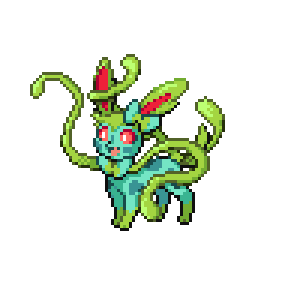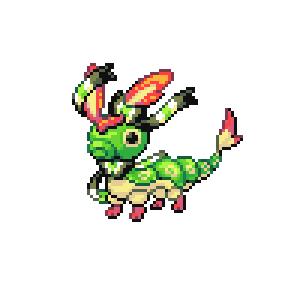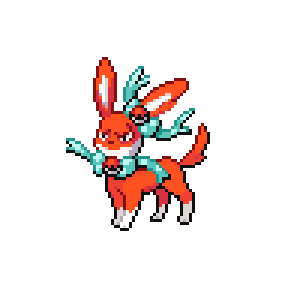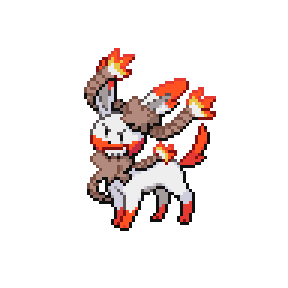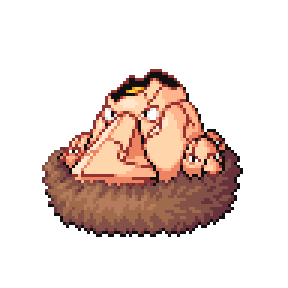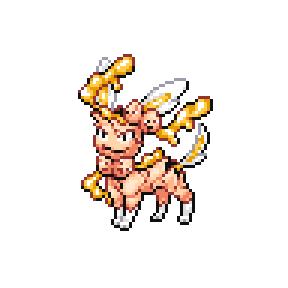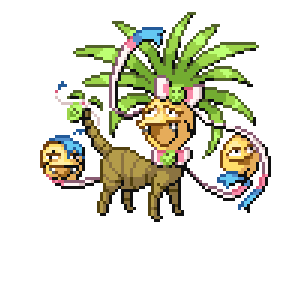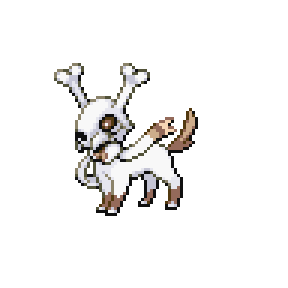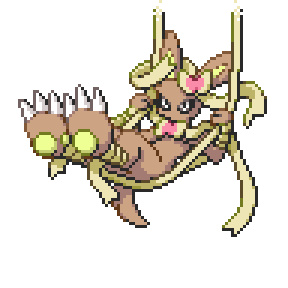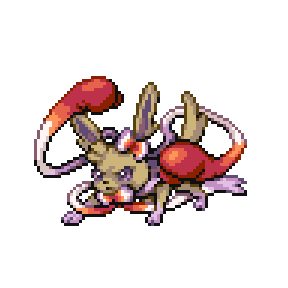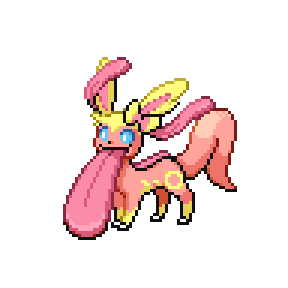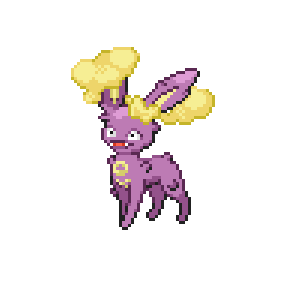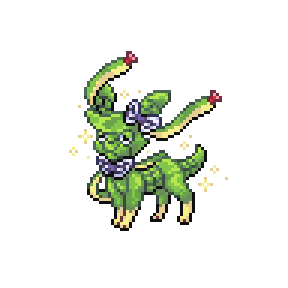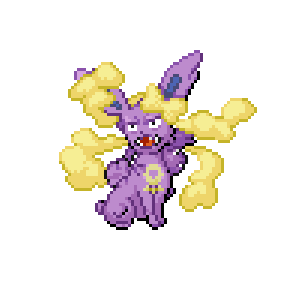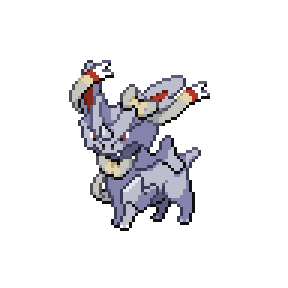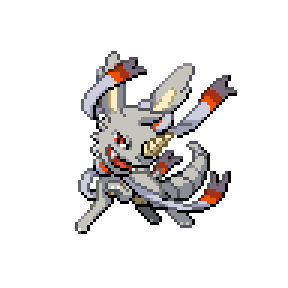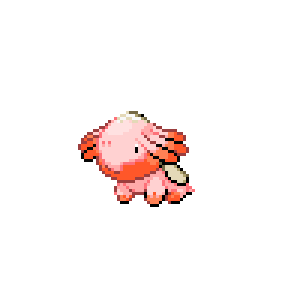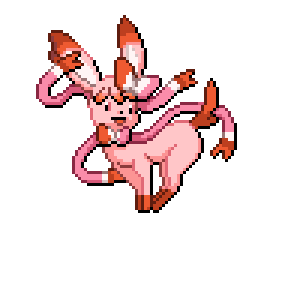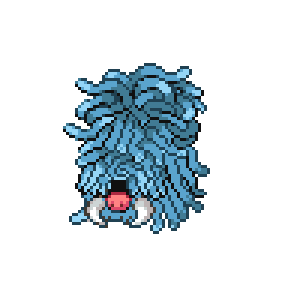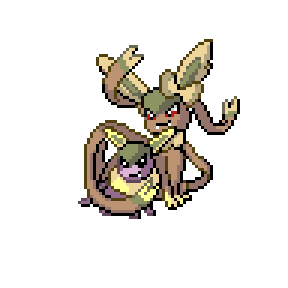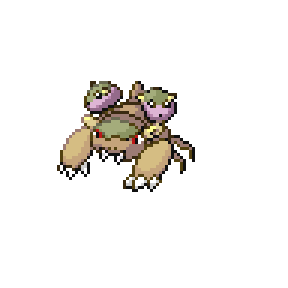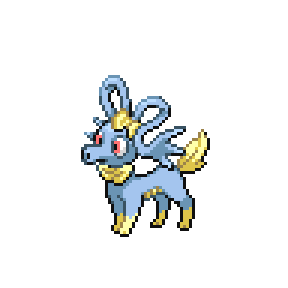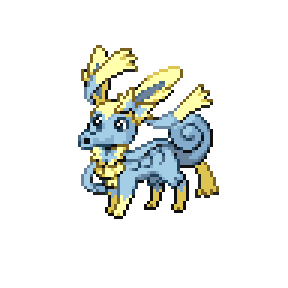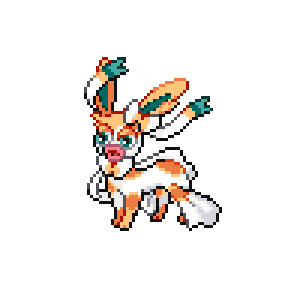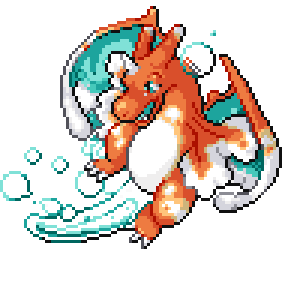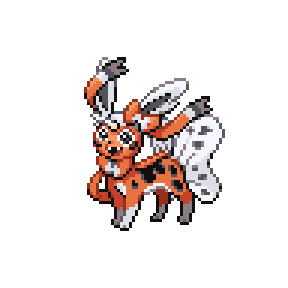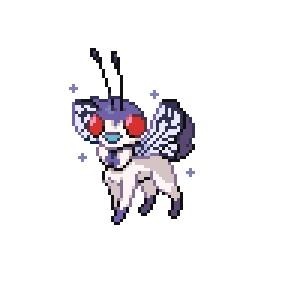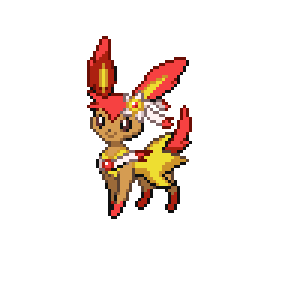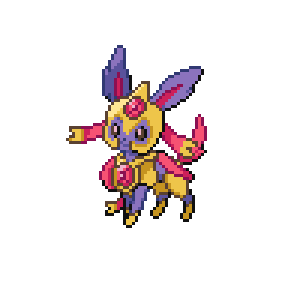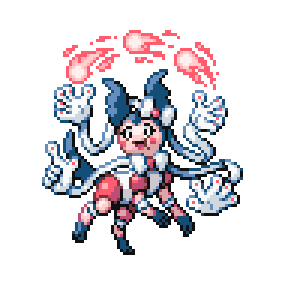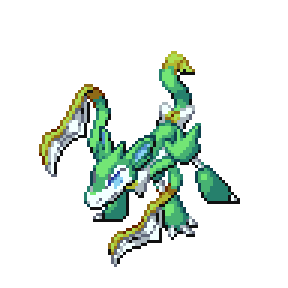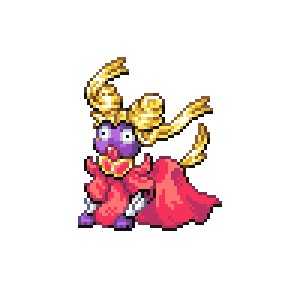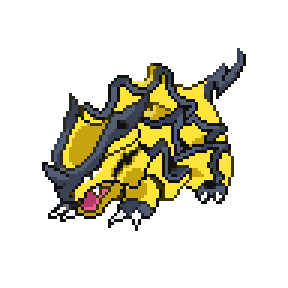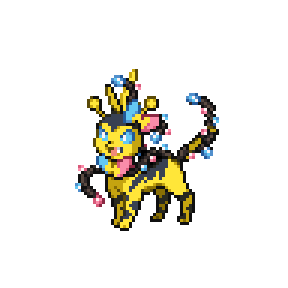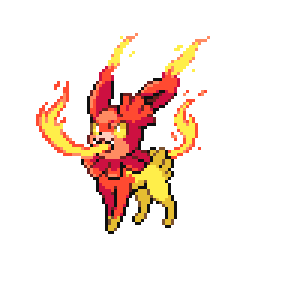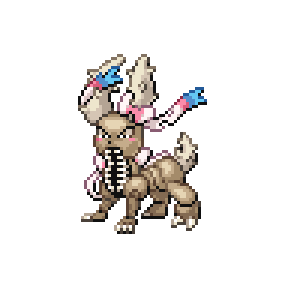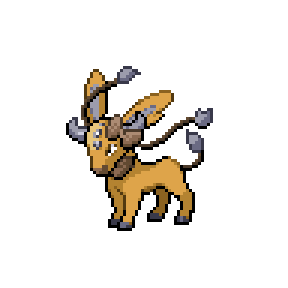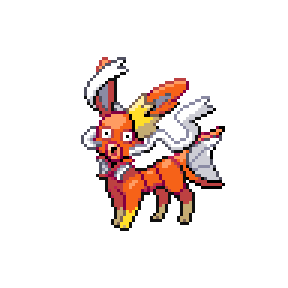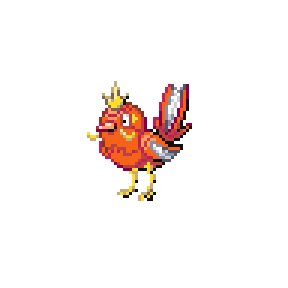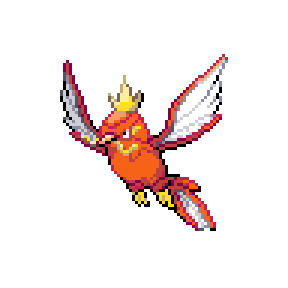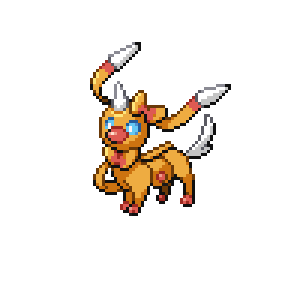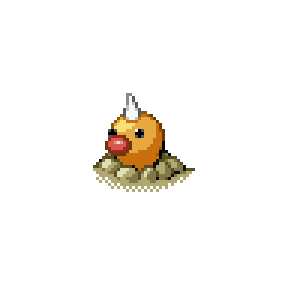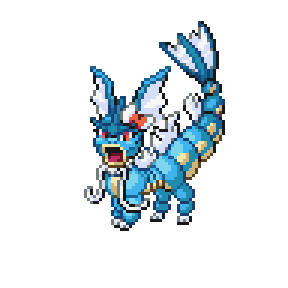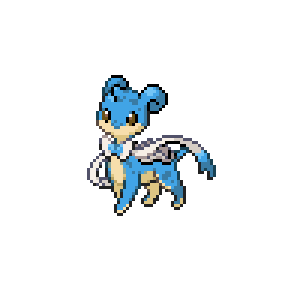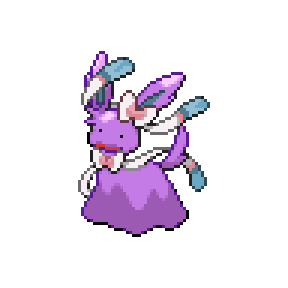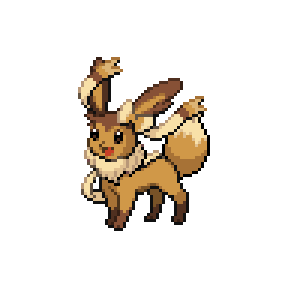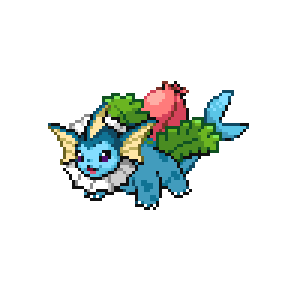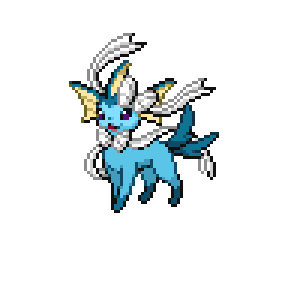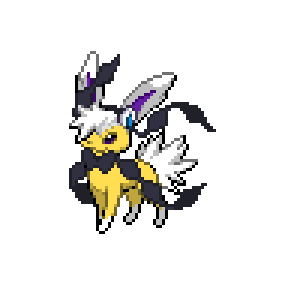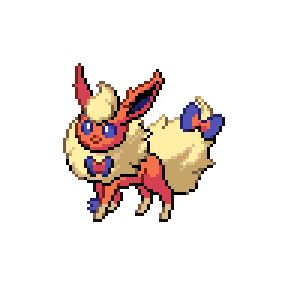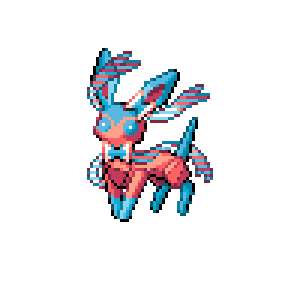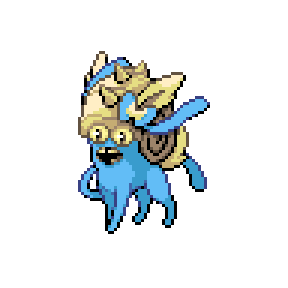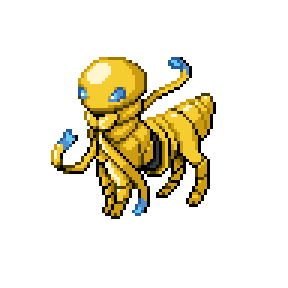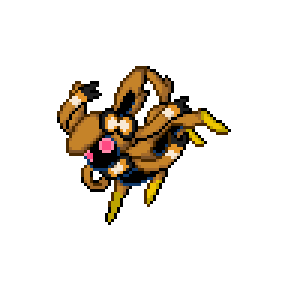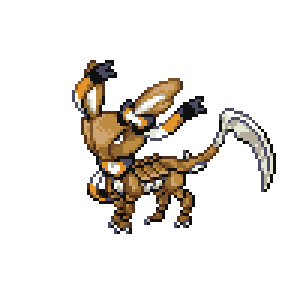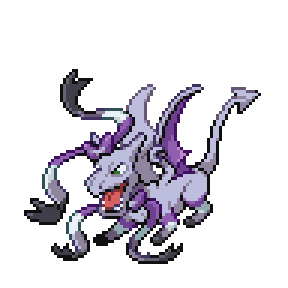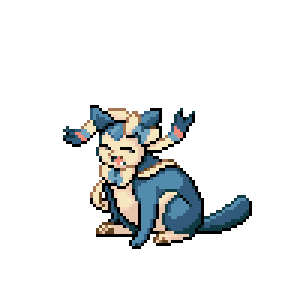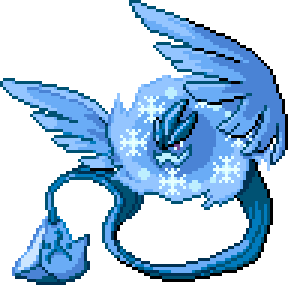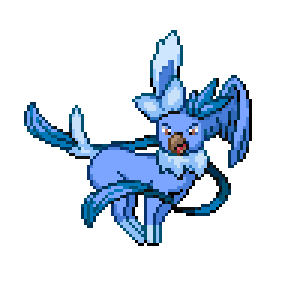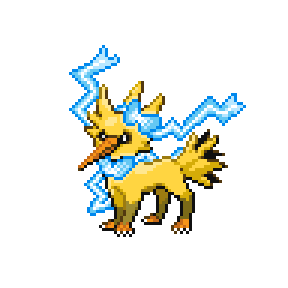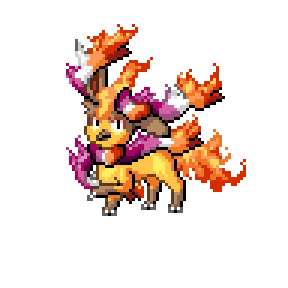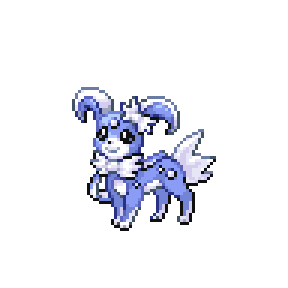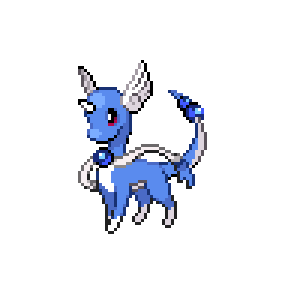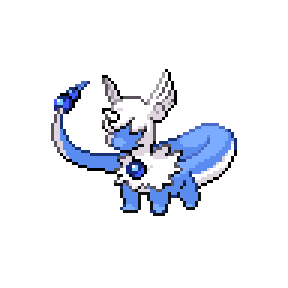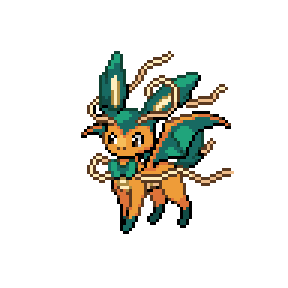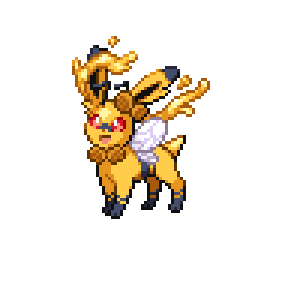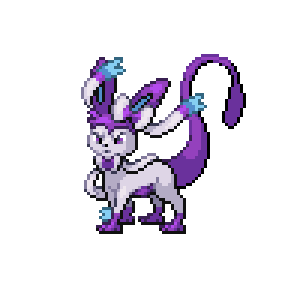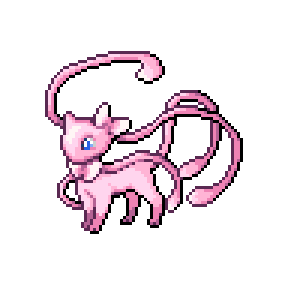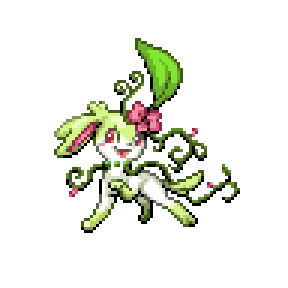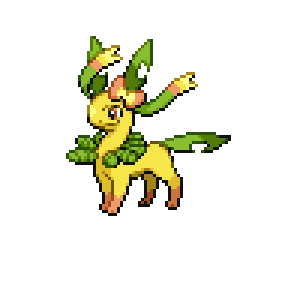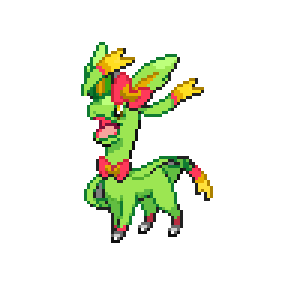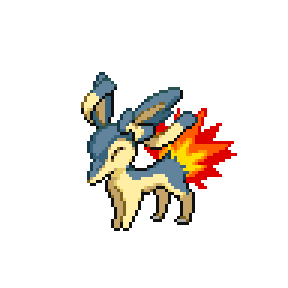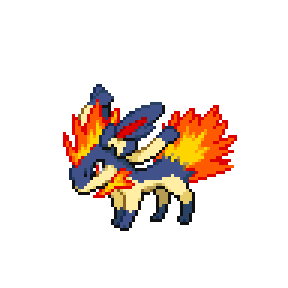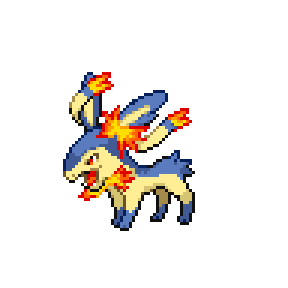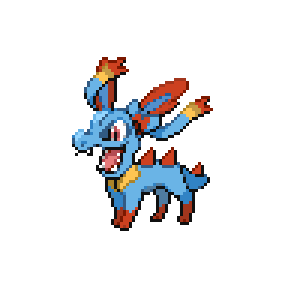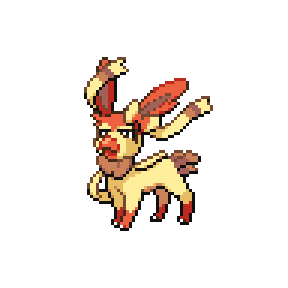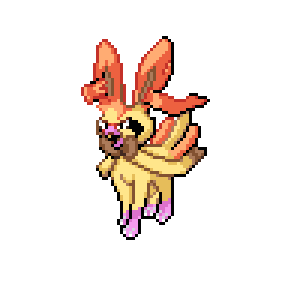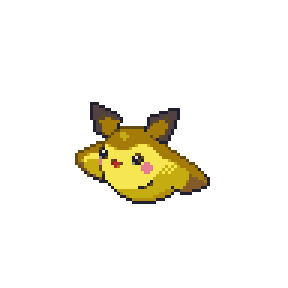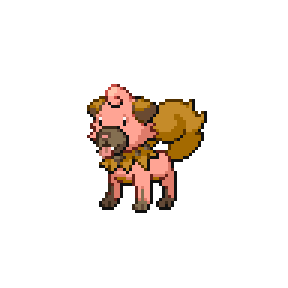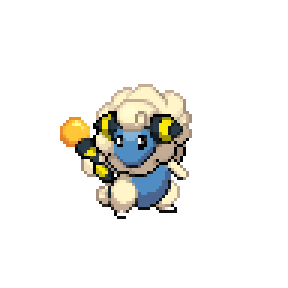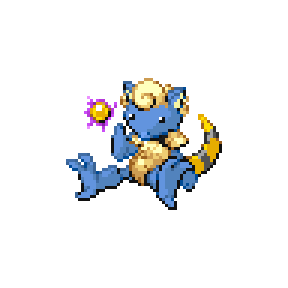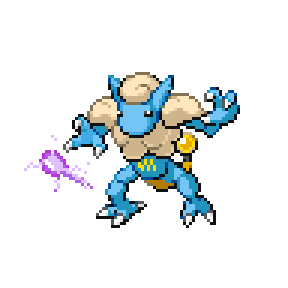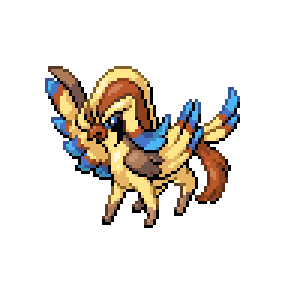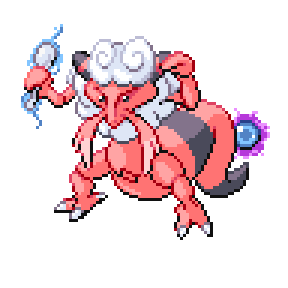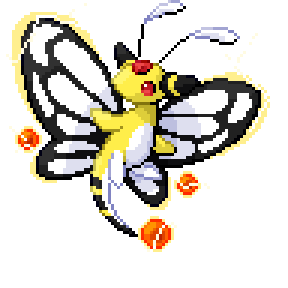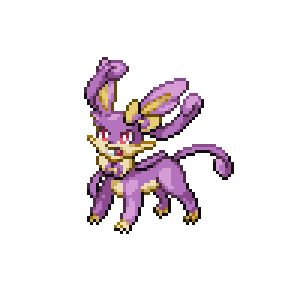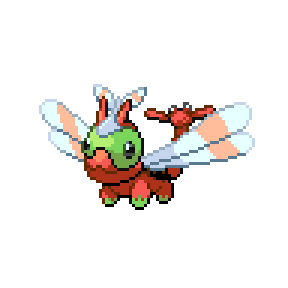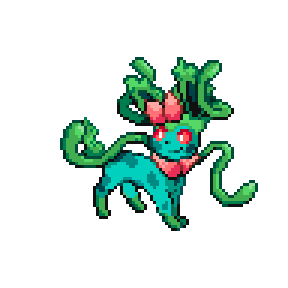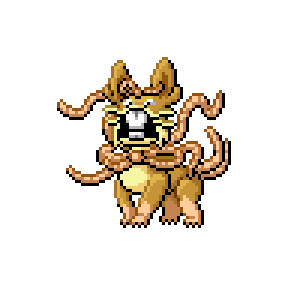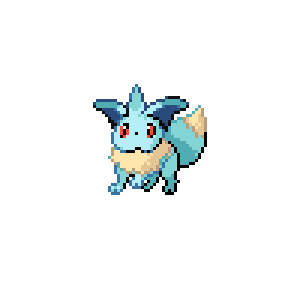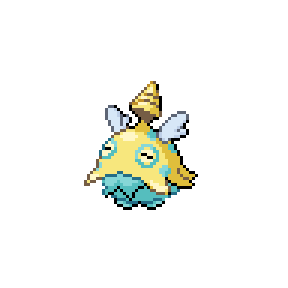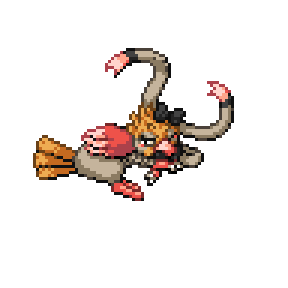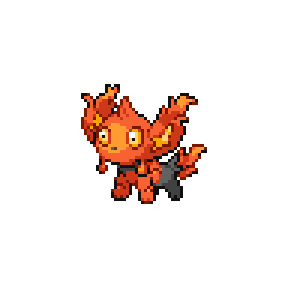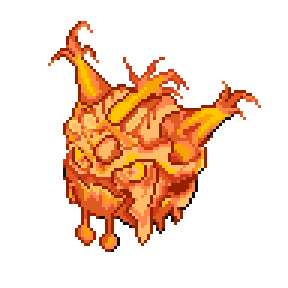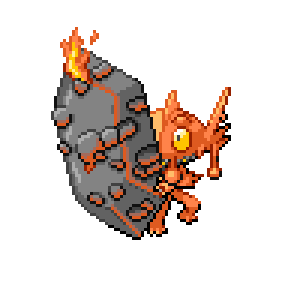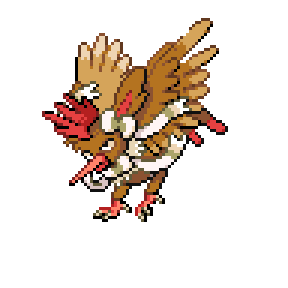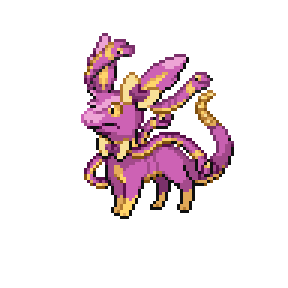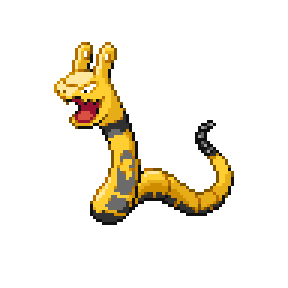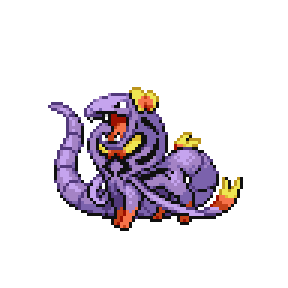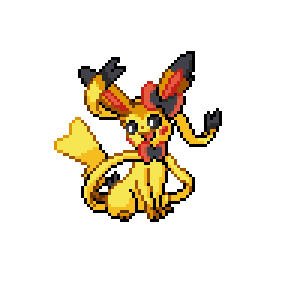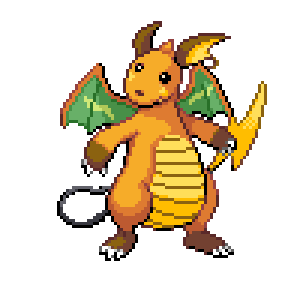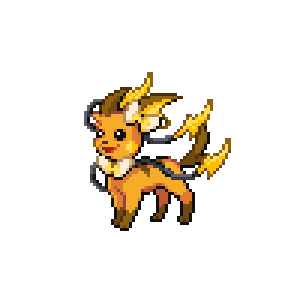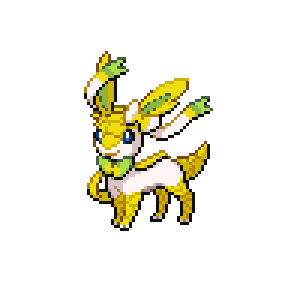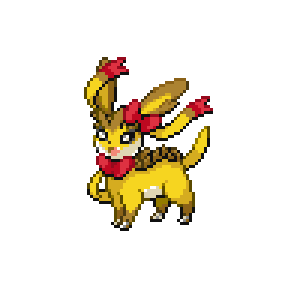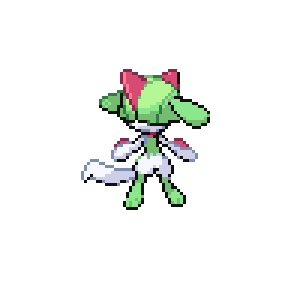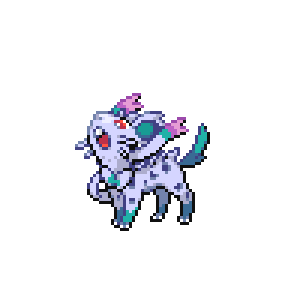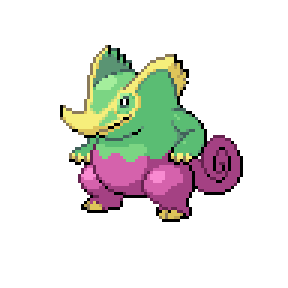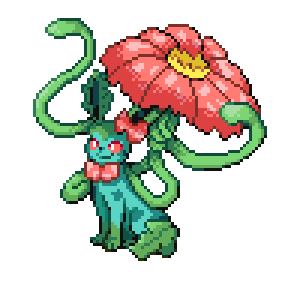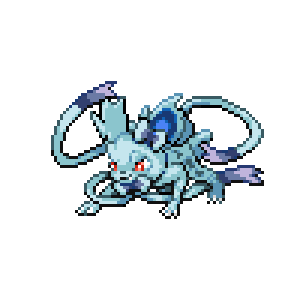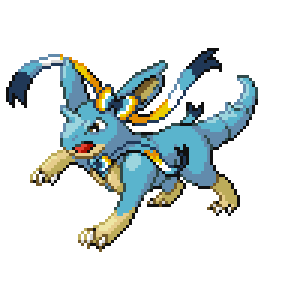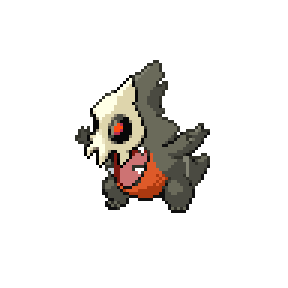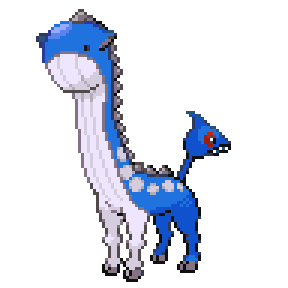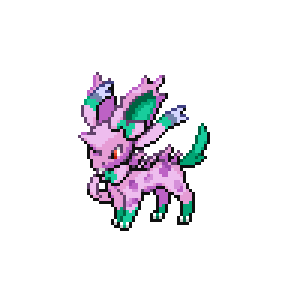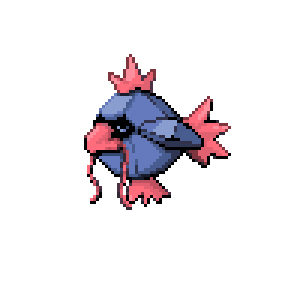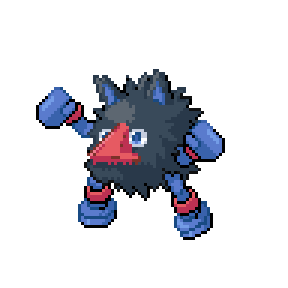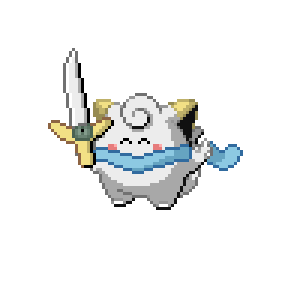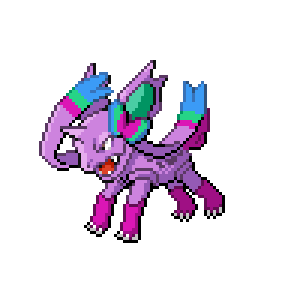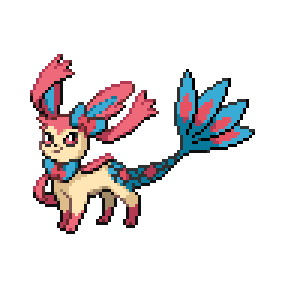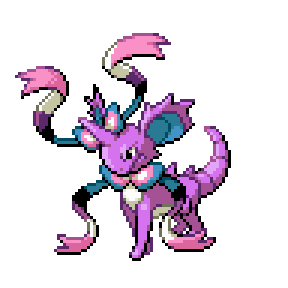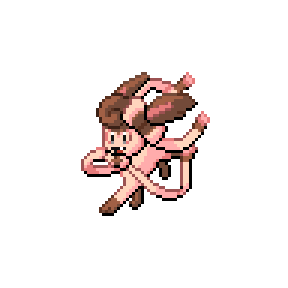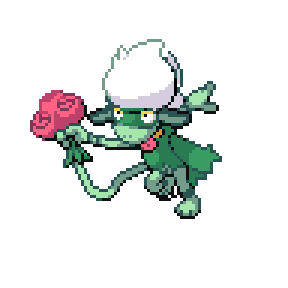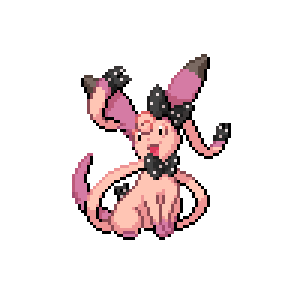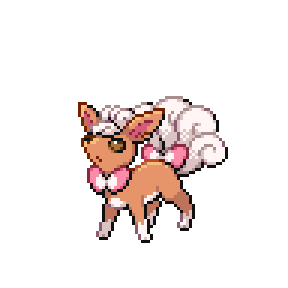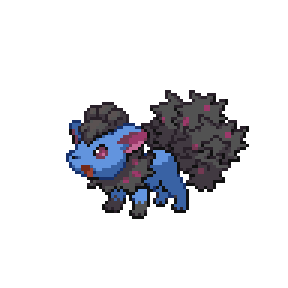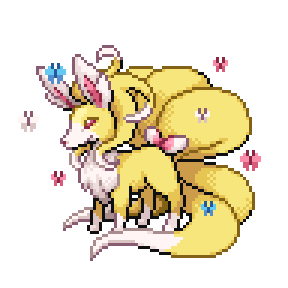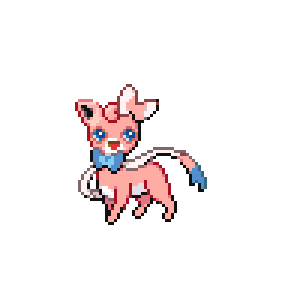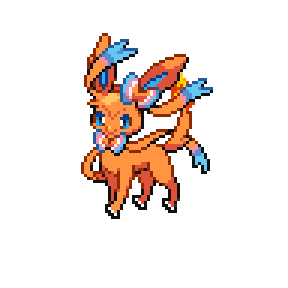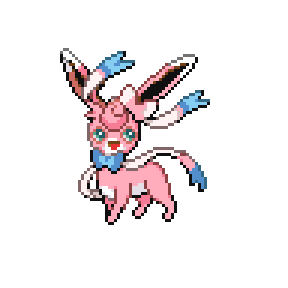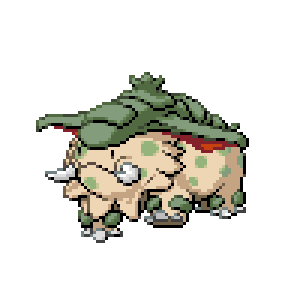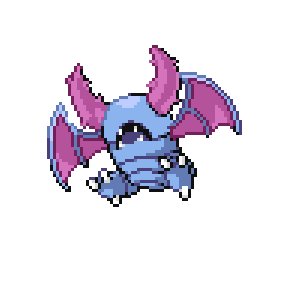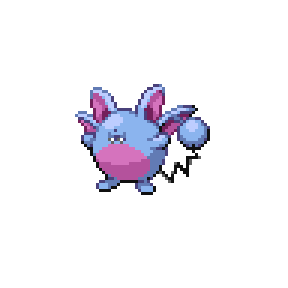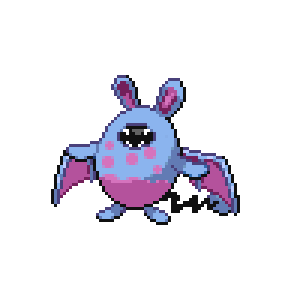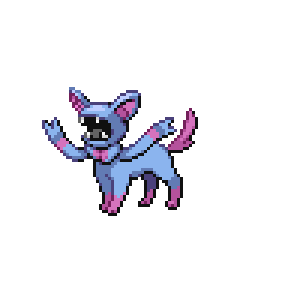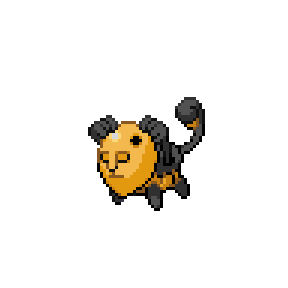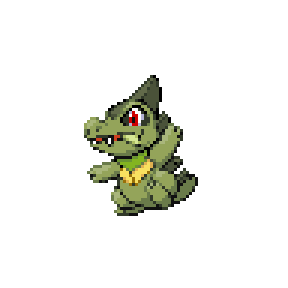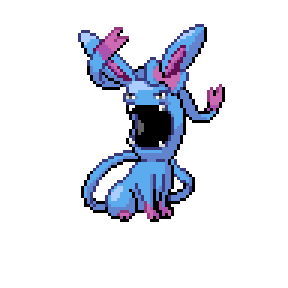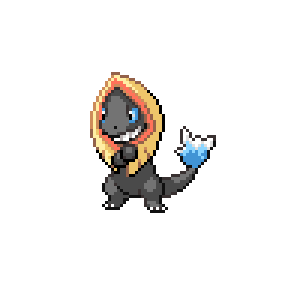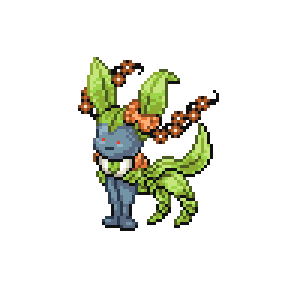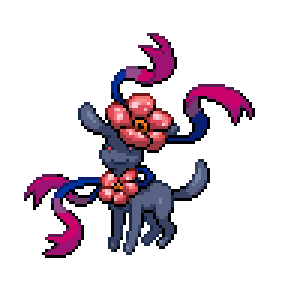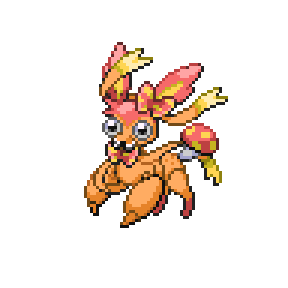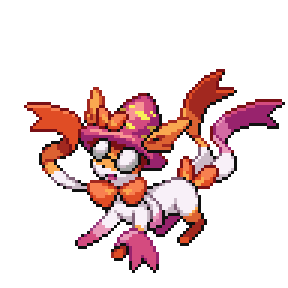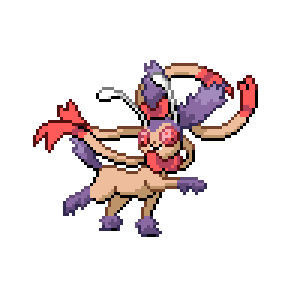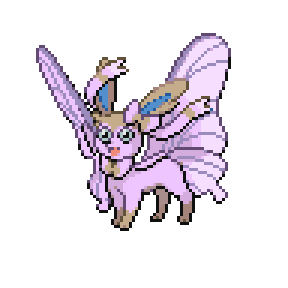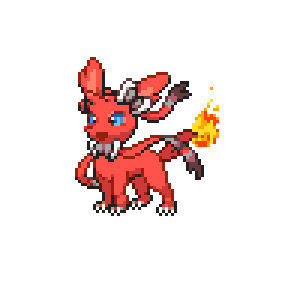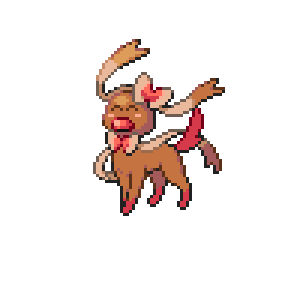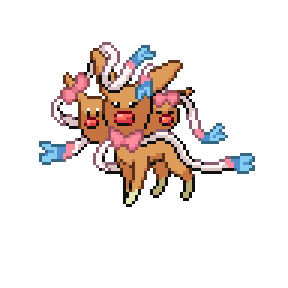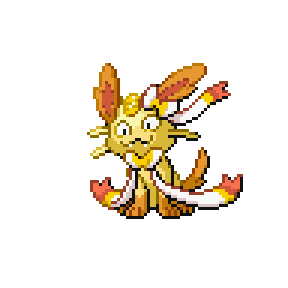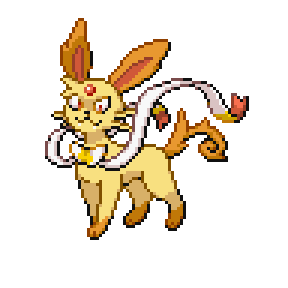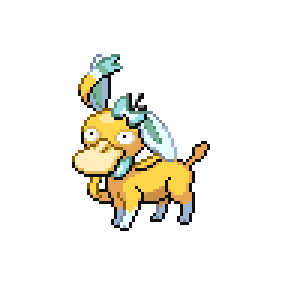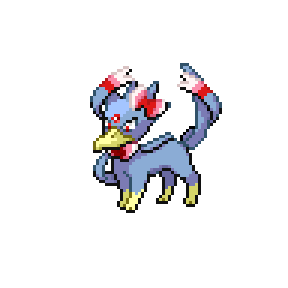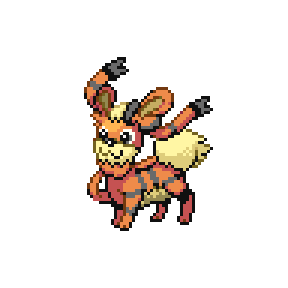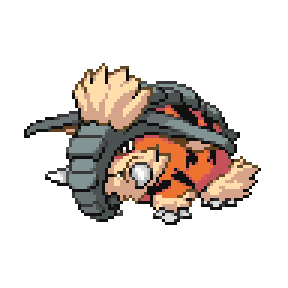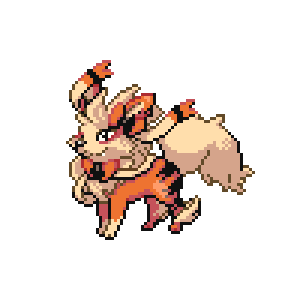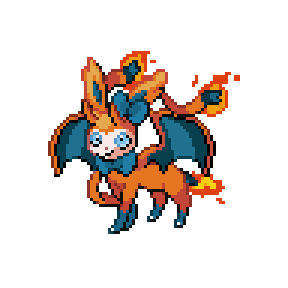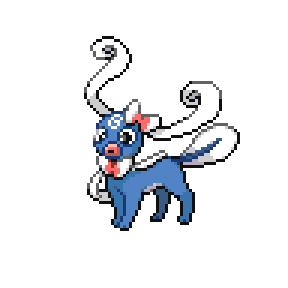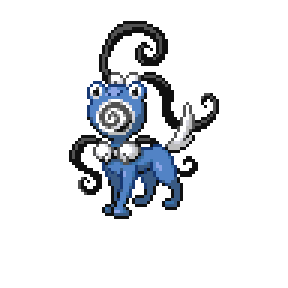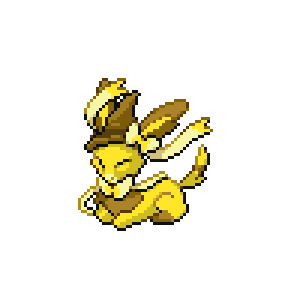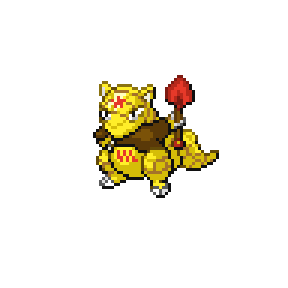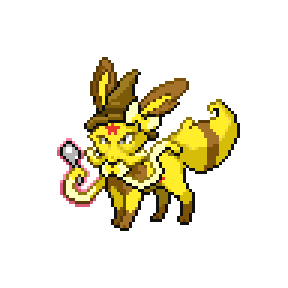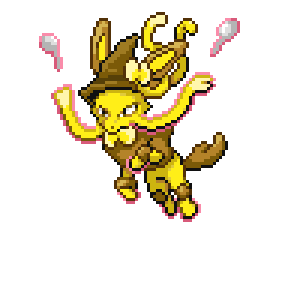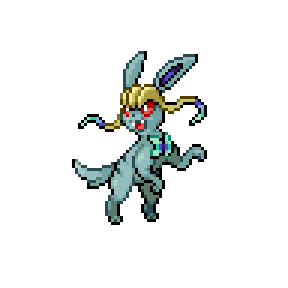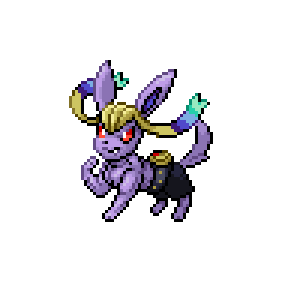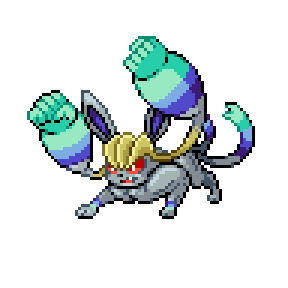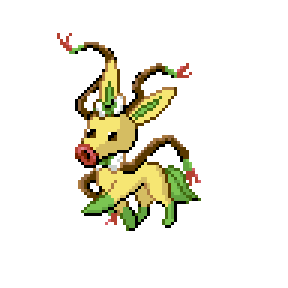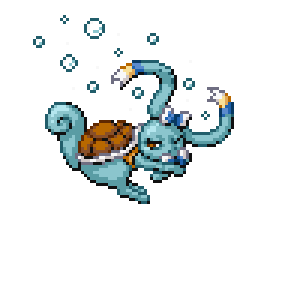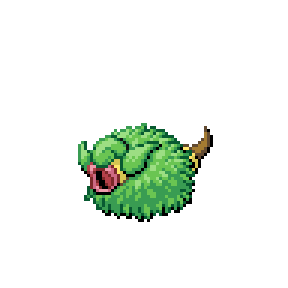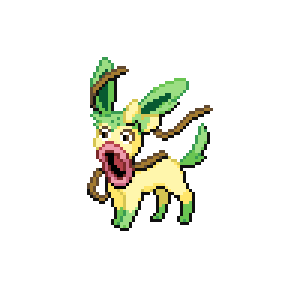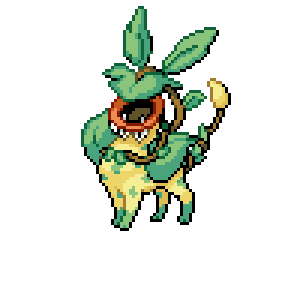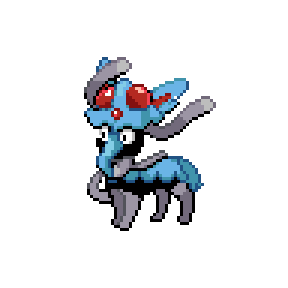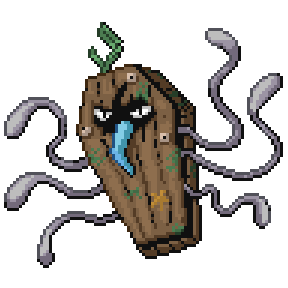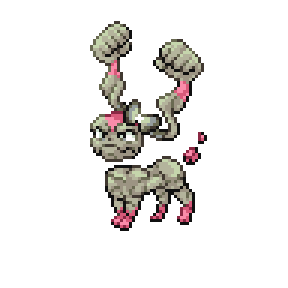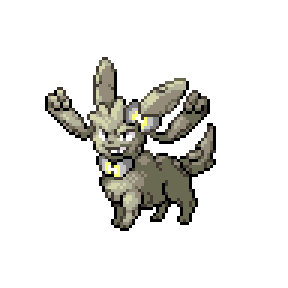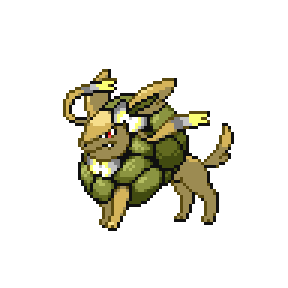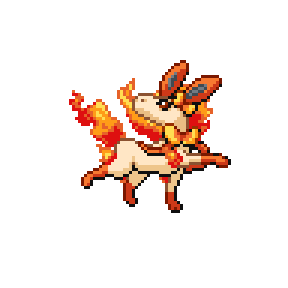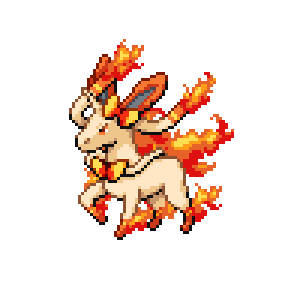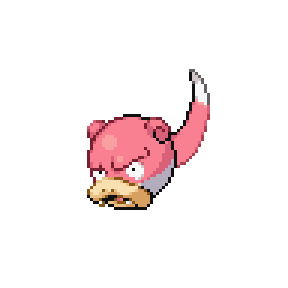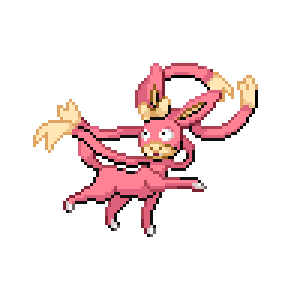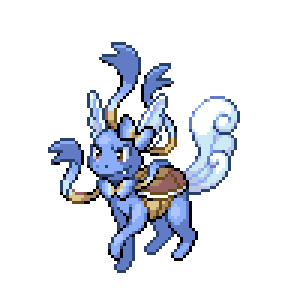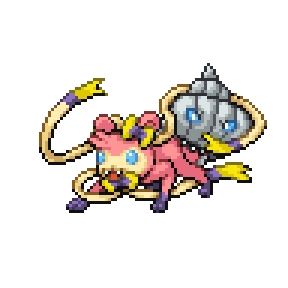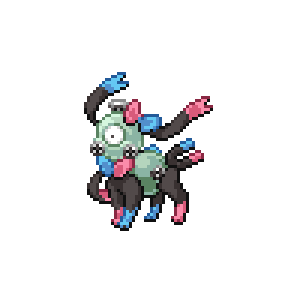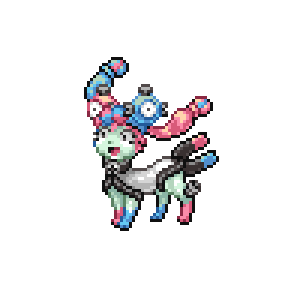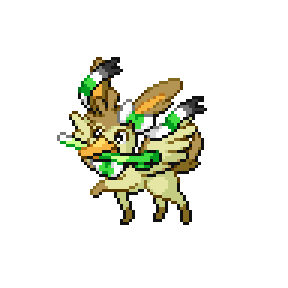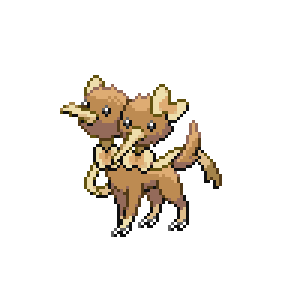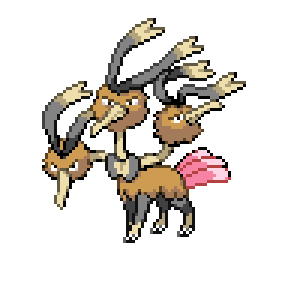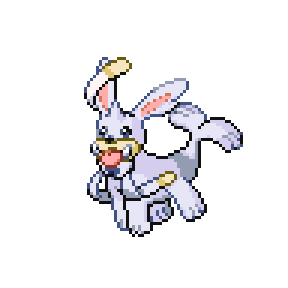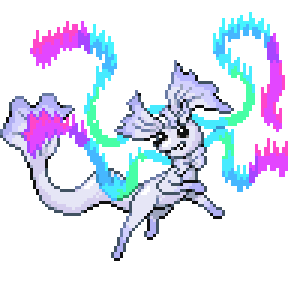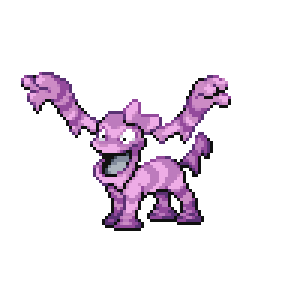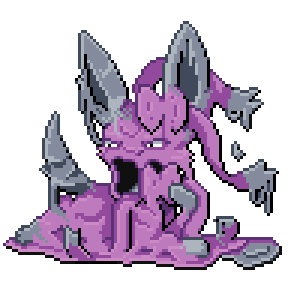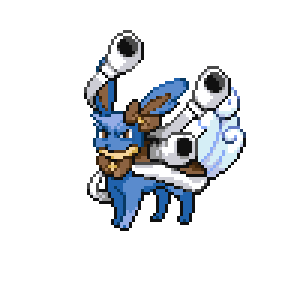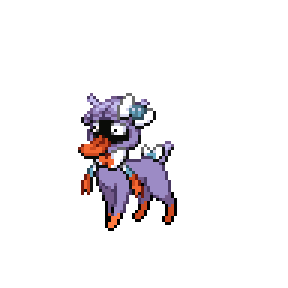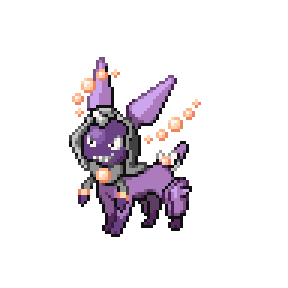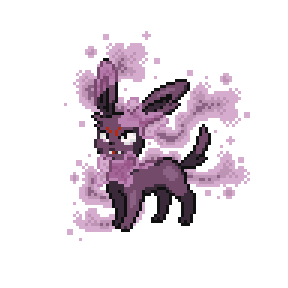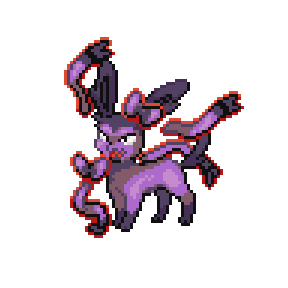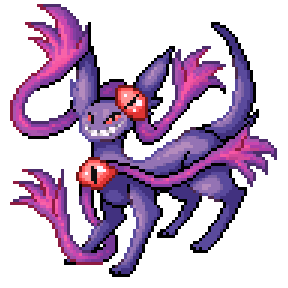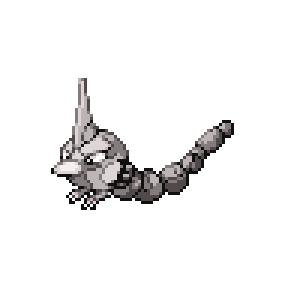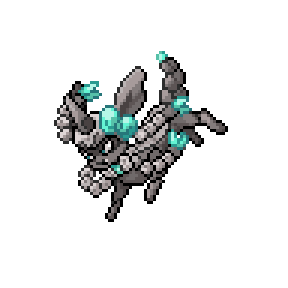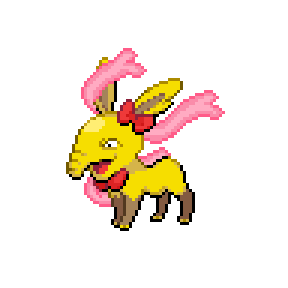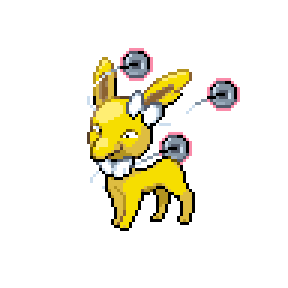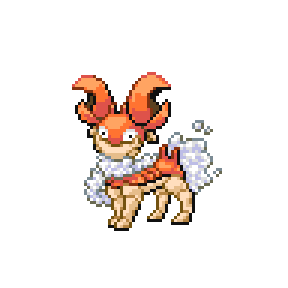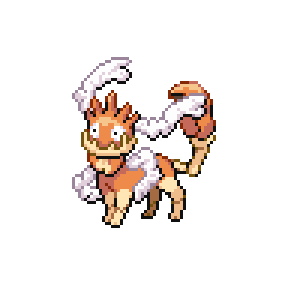This Pokémon is popular among gardeners for its cuteness. Its long, ribbon-like vines are used to absorb additional sunlight while photosynthesizing.
201 Custom Pokédex Entries by MelodyDeLune
Its long, segmented body allows it to squirm its way through narrow openings. Anything Caterveon can stick its head through, it can squirm through.
Prone to self-destruction, they are often found fainted near power plants. The ribbons on its body are made of pure electricity.
If one comes across an Electrveon and its fuse is burning, they should run. This signifies it is about to self-destruct.
The largest part of Exeggpass's moustache acts as a nest to protect its siblings. Its magnetic field keeps them from being separated.
Its siblings bud off the main body of Exeggveon. The yolk it produces feeds its siblings until they are able to split off onto their own.
The head on its tail grows in hot, humid climates. When they drop the head, it will go on to become an Exeggveon.
No one has seen the true face of Cuveon. The skull it wears is theorized to be that of a pack member that passed on.
It rhythmically fights with a combination of its ribbon-like limbs and high-powered kicks. Its kicks can lengthen out over twelve inches!
Its lightning-fast punches are nearly impossible to see with the naked eye. Professional boxers will practice their guards with this Pokémon.
It inspects everything in its environment with its tongue. Its sense of taste is over 100 times more powerful than a human's.
Its body is full of gases that are lighter than air, keeping it aloft. These gases are volatile around open flames.
Its hardened body is difficult to move. Therefore, it will often use its long ribbons as hands to grab objects and defend itself.
The gases produced by Weeveon are dense enough to be used as limbs. The gases are also often used in Kalos to produce high-grade perfumes.
They make excellent partners for demolition workers due to their ability to smash through the toughest of skyscrapers.
Its horn helps this Pokémon burrow through dirt at high speeds. It can dig up to 10 miles deep in a single day.
The harden shell of Chanwig is formed from the remnants of the egg it was hatched from. It's known to nurse sick Pokémon it finds in the wild.
Its compassionate nature makes Chanveon an excellent partner for medical professionals. They assist surgeons by handing them tools with their ribbons.
The mass of tentacles that encase Tanswine's body protect it from the cold. It uses a combination of its tusks and nose to guide itself.
Kangasveon swaddles its young by wrapping its ribbons around them. If they let you hold their baby, it is a sign they trust you completely.
Its young develop from the mushrooms that grow on Kangasras's back. When the young reach maturity, they will fall off their mother.
It uses its ribbons to help it aim where it fires its ink. They often challenge Pokémon twice their own size.
Its coiled tail acts as a rudder in water. They use their ribbons and legs to paddle at speeds that allow them to swim against strong currents.
Known as "The Sea Princess," they swim by swishing their dress-like fins and legs. They are high-value pets for the rich because of their beauty.
In spring, groups of Golizard can be seen migrating to the streams and rivers of their birth. The water they spout leaves intense burns on their prey.
Once a year, groups of Seaveon gather by the shore to perform courtship rituals. Males will attract females with vibrant patterns and dances.
It can collect massive amounts of pollen and nectar to produce honey. Its wings spread a powder that calms its enemies.
Its beautiful pattern and colors make this Pokémon popular among water specialists. It can regenerate limbs that have been lost in battle.
The golden parts of its body act as a natural armor for Starveon, being made of bone. The gems on its body are the conduits for its psychic abilities.
Mr. veon are happiest when they entertain people and Pokémon. They are excel in sleight of hand and juggling.
Their scythes can be moved very precisely; they can cut a single blade of grass in a single slash without disturbing the surrounding blades.
Their natural rhythm and delicate singing voices make them a favorite Pokémon among musicians. When they are young, they often trip over their fur.
Herds of Electahorn will gather on mountainsides during thunderstorms. They compete to determine who will be allowed to get struck by lightning.
They can use their feelers as cables to absorb electricity. Electaveon will often stand on rooftops and act like lightning rods during storms.
If the flames on its ears and tail seem low, Trainers should feed their Magveon charcoal. It becomes sluggish when its flames are dim.
It attacks by charging pincers-first towards its targets. Its large mouth allows it to swallow most prey in a single bite.
Herds of Tauveon play by locking their horns in play fights. They have high stamina and can run for hours without rest.
Though weak in terms of power and speed, they are able to live in any body of water. They use their long whiskers to feel their surroundings.
Its weak wings cannot maintain flight for long periods of time. A gentle breeze is enough to send Magiling flying off course for miles.
With its evolution, its wing power has increased. Now instead of being flung off for miles by the breeze, it is only yards.
When defending itself from predators, it jabs its spiked ribbons into them, filling them with a numbing poison.
Weelett protects itself from predators by burying itself under the ground and leaving the spike atop its head exposed.
Legends say the first Gyaraveon came from a Magiveon that swam up a mighty waterfall by only splashing.
Lapveon love to swim in open waters with their Trainers. They are often used by lifeguards to help save drowning people and Pokémon.
When first discovered, scientists believed this Pokémon was a Ditto mid-transformation into a Sylveon. Its DNA is extremely unstable.
It is theorized that Eeveon is the result of an Eevee that retained its unstable genetic makeup when evolving into a Sylveon.
The flower on Vaporsaur's back serves two purposes: it helps it blend in when near the surface, and it provides nutrients through photosynthesis.
When Vaporveon have hooked their prey, they are filled with a soothing aura that makes it stop struggling against them.
Its needle-like feelers are used to pierce their prey and release up to 10,000 volts of electricity.
This Pokémon loves to cuddle with its Trainer. It's often said that the feeling of a Flaveon on one's lap feels as toasty as an electric blanket.
Poryveon is an artificial Pokémon that was created in Kalos to test the idea that any Pokémon could be replicated through computer code.
Its sharp beak allows it to pierce through even the toughest shells. The weight of its shell makes it move extremely slowly.
Being virtually immobile while clinging to a tree, Kakveon gains nutrients by luring in prey with its ribbons.
Over the millions of years it has existed, it adapted feelers to pull prey under its shell to eat. When threatened, it will disguise itself as a rock.
Its sickle-like tail allows it to cut through prey with ease. When swimming, Kabuveon will tuck its tail up against its body.
Its piercing cries can be heard from miles away. Their ribbons-like feelers keep prey bound while they feast.
This Pokémon is often brought to retirement homes due to its docile and sweet nature. They spend up to 20 hours a day sleeping.
Spirits that have passed in blizzards gather to form Artitomb. This powerful spirit is bonded to a frozen keystone.
This legendary Pokémon can create magnificent wings by coating its feelers in a thick coat of ice. Wherever it flies, it snows.
This legendary Pokémon is said to dance elegantly amongst thunderclouds, with the ability to pounce down among bolts of lightning.
This legendary Pokémon was born in the heart of a volcano. It's said that seeing this Pokémon is a sign of spring coming.
During the beginning of Draveon's life, it will live on the floor of rivers and lakes. As it sheds its skin, its feelers will grow longer.
This majestic Pokémon is often given offerings by villages in hopes of good weather. It's said its cry can calm the fiercest storms.
Dragono's snowy habitat has led it to adapt patches of thick fur for protecting its face during blizzards, which has restricted its eyesight.
Stories are told of sailors on sinking ships who had thought they were doomed only to find themselves brought to land by Dragoveon.
Beeveon is an extremely territorial Pokémon, refusing to share as much as a drop of honey with anyone but a trusted Trainer.
Created by humans to be the ultimate weapon, Mewveon has left its past behind to forge its own path. Those who come near it find they can't fight it.
Appearing only to those of pure heart, it is a very playful Pokémon. It does not seem to grasp its level of power.
Chikoveon that have become close to their Trainers will give them their petals. These petals can be used to brew a tea that has a rich, calming flavor.
The buds around its neck emit a spicy aroma that acts as a stimulant for humans. Bayveon are often used in rescues during landslides.
Known by farmers as a symbol of the harvest, Megaveon are said to roam the countryside, reviving crops and plants that have withered.
The flames on its tail burn brightly when threatened. When fighting, they will enflame their ribbons and lash them out against their foes.
Its fur is completely non-flammable; however, it secretes an oil into certain parts of its body to engulf them in flames to ward off predators.
When its rage peaks, Typhveon will rub their ribbons together to create large explosions. Trainers should be weary if they enter their habitat.
In the water, they will snap their powerful jaws down on prey and hold them in place with their feelers.
It uses both its ribbons and beak to look for seeds to eat. It is popular among rookie Trainers for its docile nature and ease of training.
Soaring around its territory, this Pokémon acts as a defender of weaker Pokémon in the forests it inhabits.
Pityke has difficulty retaining its electricity. While swimming, it will often release a burst of electricity that's then conducted by the water.
On moonlit nights, Clefruff can be found along mountains searching for shiny rocks to decorate their fur.
The pole it carries acts as a battery to store the excess electricity built up within its thick wool.
It builds up its psychokinetic abilities through the static electricity in its wool. A herd of Mara can be seen from miles away from the light they emit from their static buildup.
The silver spoon it carries with it acts as a crosshair aiming its electrical attacks. It can aim its attacks so precisely it can hit a target from 100 yards away.
Pidveon will often perch on the shoulders of Trainers it trusts. It emits a soft, cooing sound around Trainers it likes.
The static electricity it builds up in the fleece around its head stimulates its brain, amplifying its psychic abilities.
It uses the light it emits at night to gather nectar to produce honey. This light is also bright enough to ward off predators by blinding them.
Skittish in nature, Ratveon loves to explore its area. Trainers are advised to keep stimulating toys around if seeking this Pokémon.
Living along lakes, Yanwig will buzz around fruiting plants to eat. Their eyes allow them to see approaching threats 360° around them.
The petals of Ivyveon emit a pleasant floral scent when it is happy. Ivyveon can often be found napping in the sun.
Known for its high IQ, this crafty rodent Pokémon uses its paws and hand-ribbons to solve various puzzles it finds. It requires extra attention.
Popular among bug catchers, Pinevee has rough fur that helps to protect it in the wild.
Using the drill tip on its head, Dunish tills soil to make it it more nutrient rich for consumption.
Quick to aggravate, this Pokémon will incessantly peck at anyone who wanders into its territory.
Living in volcanic areas, its diet is composed of coal and volcanic rocks. If it desperately needs a recharge, it will consume wood to fuel itself.
Dazzling clouds of crystals surround its body. Touching one of these crystals leaves one with a chill so cold it burns.
It carries around a large volcanic rock it uses as a shield. When weakened, it will make a new shield with its high-temperature claws.
Its large, powerful wings allow Fearveon to remain airborne for long periods of time without needing to land.
Its extra heads contain no brain, but they work as extra mouths that Ekveon can launch to reach food its body can't.
Eleans produces a poison with paralyzing properties. It recharges itself by swallowing its tail and rolling around.
The brightly colored patterns on its chest warn predators of its highly toxic venom. A single bite can leave a target unable to move.
Pikaveon uses its ribbons like jumper cables to latch onto its target and fill it with electricity. It's often used by mechanics to jump-start cars.
This kindhearted Pokémon has been known to guide ships during storms, using its body to absorb lighting strikes as it flies.
It communicates with other Raiveon by connecting their lighting-shaped ribbons and sending shocks between them.
By coiling its ribbons together and spinning them like a drill, Sandveon can burrow its way rapidly into the ground.
When threatened, this Pokémon will curl into a ball and lash out with its ribbons. It can dig up to 10 kilometers deep in a single day and night.
Ralolu's psychic abilities manifest through its connection to aura. Due to its small body, it has difficulty controlling these powers.
If attacked by a predator, Nidoveon will latch its ribbons onto its attacker and slam them into the poisonous barbs on its body.
Blending in with the background, it eats the bad dreams of people and Pokémon. If you had a bad dream but forgot what it was, Keczee has eaten it.
The floral parasol of Venuveon acts both as a source of nutrients when conducting photosynthesis and as a way to gather water during rain.
Known to be gentle around friends, Nidoveon can emit ultrasonic cries that can paralyze enemies. It can retract the poison barbs on its back.
Extremely protective of those it cares about, this Pokémon will stake its life to ensure the safety of its young and Trainer.
The skull mask on the face of Dusble is used to ward off predators. The jagged edges of the mask assist it when eating.
Sporting the longest neck of any land Pokémon, it can see predators approaching from miles away. The front head is very docile, while the back is not.
Its large ears allows it to hear threats coming from far away. Its poison barbs grow larger the more poisonous it is.
Its nose is used to navigate the currents of the seas it inhabits. Its rock-hard body defends it from predators.
Using its strong magnetic field, it coats its fur in metal to act as armor for its body. Its punches are equivalent to boulders being thrown.
During a full moon, groups of Honfairy gather to forge their swords out of Moon Stone fragments. They will carry these swords with them at all times.
Quick to anger, these Pokémon will latch onto anything it perceives as a threat with its ribbons and jab it with its poisonous horn.
Living in the seas, you will know it is near by its harmonious singing. It is thought this Pokémon is the origin of the myth of mermaids.
Its rock-hard hide helps protect it as it defends its burrows from threats. It is known to treat its Trainers as if they were its children.
This Pokémon has an immense amount of admirers due to its cute looks and playful spirit. It makes an excellent pet, though it is extremely rare.
Using the fruit produced by the flower on its tail, Rosegle will produce the ink it uses to paint. It marks its territory with this paint.
Clefveon are wary of humans. Their large ears are constantly monitoring the environment of possible threats.
When Vulveon is born, it only has one tail, but as it ages, its tails split into more. It can use each of its tails as an additional limb.
The dense fur along its neck and tails is hardened and rough. Deipix uses its tails in nature to tear through thick brush.
Its calm and intelligent nature has made Nineveon popular amongst families. Its long lifespan has led to stories that it can live for a millennium.
Jigglyveon is popular amongst daycare workers due to its soothing singing voice and ability to calm fussy toddlers with its ribbons.
The happier this Pokémon is, the warmer its body feels to the touch. It often seeks to cuddle with a trusted Trainer.
Its rich, fluffy fur feels so good to touch that people find it difficult not to touch it. Cuddling Wigglyveon is used to help insomnia patients.
Rolling around to travel, Shroomphan will spread its spores as it goes. In a single day it can plant over 10 miles of spores.
Its ears have adapted, due to its lack of eyesight, to act as a set of mandibles to capture prey.
Using its echolocation, it can find fruit within miles of its location. When resting, Zurill will cling to the shoulder of its trusted Trainer.
Zurill builds up its poison reserve by eating the seeds of the fruit it survives on. They are only known to use this poison as a last resort against potential threats to it or its Trainer.
Being born blind, Zuveon uses echolocation and its ribbons to feel its surroundings. When around something it doesn't recognize, it will nibble it.
Ancient civilizations would craft masks of departed loved ones for Yaon. This Pokémon will guard the burial site of the person their mask matches.
Its combination of tusks and razor-sharp teeth gives this Pokémon an intense bite force. It plays by nibbling, causing many injuries to Trainers.
It drinks up to 10 ounces of blood during any feeding. Its ribbons makes it easier to hold its prey before it bites.
The icy crystal formed at the base of Snomander's tail indicates its current health. The deeper blue in color it is, the better its internal temperature is being regulated.
It creates a false torso with the leafage on its back. When attacked by predators, it will shed this false body and flee.
The large flowers on its body emit a calming aroma that pacifies anyone that comes near.
They use their ribbons to spread to the spores around as they walk. Their diet consists of mulch and compost soil.
The calming nature of Paraveon's body has led it and the mushroom to form a symbiotic relationship where they both gain nutrients and protection.
Their eyes act as radars, scanning for small bugs and prey to to eat. Their ribbons allow them to dig up grubs.
Its large wings release scales that are full of toxic dust. It is often lured into civilization by the bright lights of cities.
It becomes agitated quickly if it senses its Trainer is in distress. When agitated, its flames burn nearly twice as hot.
Digveon burrows a yard underground, eating the roots of plants. Farmers have pulled up fresh vegetables only to find bite marks taken out of them.
The three heads of Dugveon all think exactly alike, allowing it perfect coordination while digging tunnels.
Fascinated by shiny objects, Meowveon can be easily befriended by prospective Trainers by offering it something that sparkles.
Perveon has many admirers, though prospective Trainers should be warned it is fickle about who it shows it's affection to.
Psyveon suffers from near-constant headaches. Prospective Trainers are advised to keep therapeutic music around and create a stress-free environment.
Golveon uses its webbed paws to swim gracefully around the lakes and slow-moving rivers that make up its habitat.
One of the most popular pets among non-Trainers, Growlveon are extremely loyal and faithful to their owners.
This nimble Pokémon can often be seen rolling around wherever it goes. It can roll for over 6,000 miles without needing to break.
Hailing from the far east, Arcaveon has been prized since ancient times by regals and royalty for its loyalty and loving nature.
The source Charveon's power is the bond with its Trainer. The closer it is bonded to its Trainer, the more intensely its fire burns.
Its newly grown legs are weak and prevent it from running. As a result, Poliveon spends the majority of its formative years in the water.
Its health deteriorates when its skin dries out. Prospective Trainers should moisturize them every few days to keep their coats shiny and healthy.
The springy elasticity of its ribbon-like appendages allows Poliveon to throw punches at mach speeds.
Sleeping for up to 18 hours a day, Abveon will cling onto those they trust with their ribbon-like feelers as they snooze.
By channeling its psychic abilities through the shovel it carries, Kadashrew can detect water within a ten-mile radius of it.
It channels its psychic abilities through its ribbon-like feelers. Prospective Trainers need to keep their curious minds busy to keep them happy.
Its superb memory lets it remember all the way up to its birth. Soldiers who have been deployed have returned to find that Alaveon remembers them.
These muscular Pokémon are often used in frozen tundras as a sled team. Interlocking their ribbons allows these Pokémon to form a tight bond.
Maveon are often used in construction for their ability to carry heavy objects with ease. They enjoy the work due to the exercise they get from it.
The muscles on the ribbons of Maveon are over twice the strength of its already powerful legs. A single punch from Maveon can shatter diamonds.
When capturing prey, Bellveon will wrap its vines around them and pull them into its mouth, which contains a corrosive fluid.
The hardened shell of Squirtveon allows currents to propel this Pokémon at vast speeds. It slows itself down in water by coiling its ribbons.
As a self-defense mechanism, Weepinreep will bury its face into its leafage. Its electricity is produced by the photosynthesis of its leaves.
Its vines act as cutters to slice food too large to pull into its mouth. The fluids it produces dissolve anything it comes into contact with.
It lures its prey in with the sweet smell of honey and then pounces on them. They swallow their prey whole and dissolve it in their strong acids.
The three Pokémon that make up its pre-evolution have fused together, creating one large jellyfish Pokémon.
Tentagrigus makes its home in containers and boxes dumped into the ocean. It will catch its prey by launching its many tentacles.
In nature, packs of Geoveon will tackle each other to prove whose body is sturdiest. The one that comes out on top becomes the leader of the pack.
To maintain its bulk and sturdy body, it will eat up to a ton of rocks on a daily basis. Its favorite rocks seem to be those covered in moss.
Goveon are popular among gardeners for their shedded skin, which hardens and crumbles, becoming a nutrient-rich soil for plant growth.
Due to their high jumping and fast running, Ponyveon are excellent herding Pokémon. Only those it trusts can touch its mane without burning.
In herds of Rapiveon, the fastest runner is the leader of the herd. They are very competitive and will race anything that they see as faster.
Often called "The Sea Mine," Sloworb is known to explode when reeled in by fishermen. Even veteran anglers are cautious about fishing in its habitat.
It uses its multitude of ribbonlike feelers to fish. If their ribbons break off, they will regrow quickly, and Slowveon will feel no pain.
It uses its tail in water to act as a rudder and its ears to detect the directions of currents.
Though usually slow, if the Shellder on Slowveon's tail bites down they will gain a burst of adrenaline to act faster than normal.
The iron balls that make up its body act as batteries to store its excess power. Their favorite foods include batteries and fridge magnets.
Resembling the look of a popular streamer from Paldea, Magneveon has become a popular among fans of the streamer.
Farveon is playful in nature. Its favorite game to play with its Trainer is fetch. It uses the stalk that it received with shortly after hatching.
Its two heads contain nearly identical brains. The heads rarely ever fight, with one exception being over pets from their Trainer.
Seeking its Trainer's praise, its three heads execute complex plans between them. When one is being petted, the other two heads will be jealous.
It prefers colder climates. Trainers should check its health to see if its nose is cold; if not, it should be brought to a Pokémon Center immediately.
The aurora that makes up its ribbons is cold to the touch. The better its health, the more vividly these ribbons appear.
Griveon are used in sewage treatment plants to help remove pollutants. They eat the hazardous material, leaving behind only sterile water.
Muveon has been employed in recent years by landfills to clean up the garbage; they will eat anything that has rotted or is a pollutant.
Its ribbons have adapted to spout highly pressurized bursts of water. These ribbons can fire water hard enough to tear through solid stone.
The hardened shell on its face will protect it from most damage. When they fight, they will close their shells and charge head first into foes.
When threatened on land, Cloyveon will shed the pearls strung along its feelers; its pearls will be replaced in only a matter of a few days.
It appears in the homes of people whose pets have recently passed. Despite being made of gas, Trainers say they feel it when it lays on their laps.
This Pokémon, despite its unnerving appearance, is very affectionate. Unfortunately, its licks have been known to paralyze its Trainer.
When walking with its Trainer, it prefers to hide in their shadow. If you are touched by its ghostly arms, you will experience a strong chill.
Using its psychic abilities, Ontu will burrow through the ground, seeking the various rocks that make up its diet.
The crystals on its body are the hardest points; it will attack by hitting its enemies with them, piercing most enemy defenses.
Often used to help those suffering from nightmares, Drowveon feasts on the bad dreams, leaving them with restful sleep.
Hypveon is used in hospitals to help put patients to sleep; the longer they swing their pendulums, the longer the patients remain asleep.
The pincers on its head make excellent weapons. When threatened, it will bash its head into targets and clamp its pincers onto foes.
The claw on its tail is incredibly powerful. However, due to the weight of its claw, it relies on dense limbs made of bubbles to keep itself balanced.
